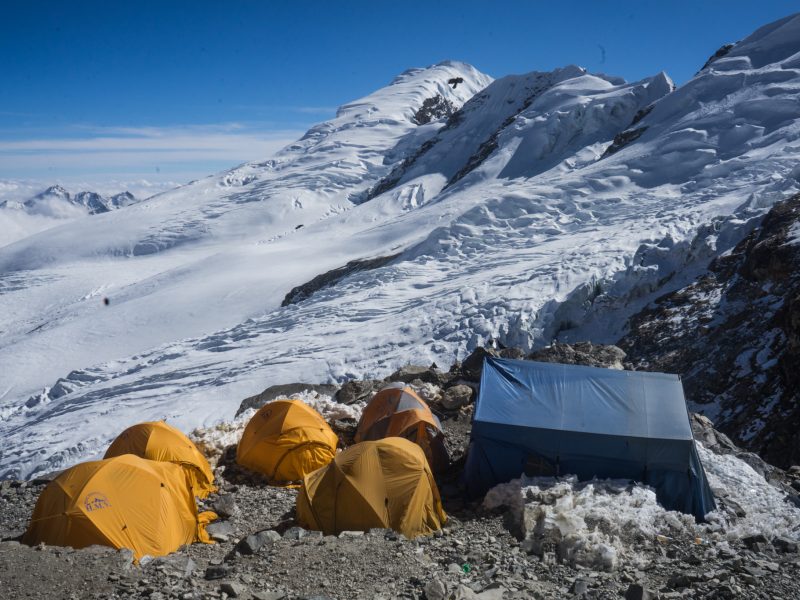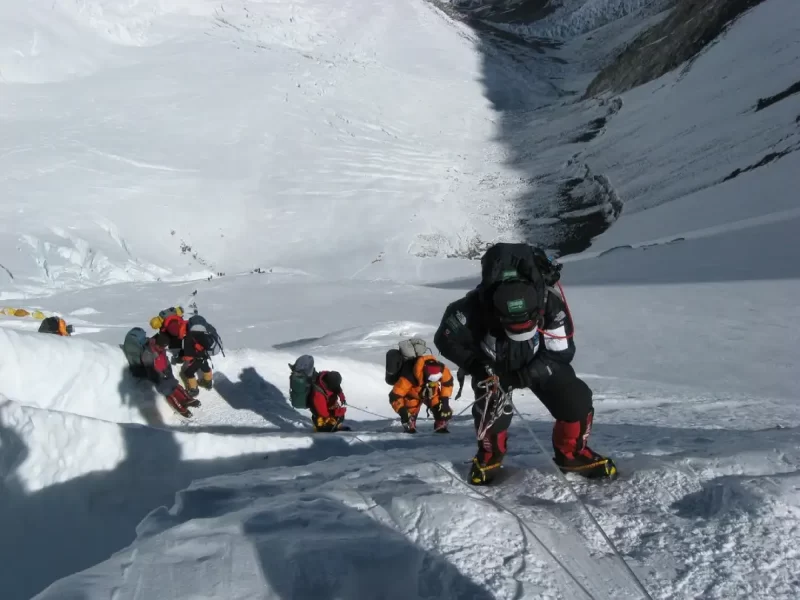The hike up Mount Everest is not as pristine as it seems, with grand Himalayan views from Camp II. However, you may find yourself in a pile of dried-up trash, possibly from the previous night. The human waste litters the four sleeping areas on Everest’s south side, presenting a minefield-like scene. Climbers have buried excrement in snow, chucked it into crevasses, or defecated near their tents over the 62-year climb. Therefore waste management in Mt.Everest is one of the priorities to be considered.
Climbers once believed harsh weather and crevasse disposal would keep mountains clean. However, with commercial guided trips and increased traffic, the amount of human waste on the mountain has increased, leaving decades worth of trash on the summit.
Campaigners advocating for a cleaner mountain estimate that climbers leave approximately 8000 kilograms of human feces on Everest each year. This poses a serious environmental and health problem due to the lack of toileting facilities, the risk of exposure, and the need for waste bags and pee bottles.
 Mount Everest’s environmental sensitivity and high number of climbers make waste management a critical issue. Therefore, base camp facilities and higher elevations have designated toilet facilities to minimize environmental impact. Climbers should use these facilities, as well as portable toilets or bags for waste disposal, and follow the “Leave No Trace” principle.
Mount Everest’s environmental sensitivity and high number of climbers make waste management a critical issue. Therefore, base camp facilities and higher elevations have designated toilet facilities to minimize environmental impact. Climbers should use these facilities, as well as portable toilets or bags for waste disposal, and follow the “Leave No Trace” principle.
Local authorities and climbing organizations set regulations to minimize environmental impacts. Climbers and expedition organizers receive training on waste management before their journey. Violations may result in penalties or denied permits. Climbers should familiarize themselves with local waste management regulations before climbing.
Everest base camp waste management is a critical issue due to its environmental impact and the need to preserve its pristine nature. Waste management practices include toilet tents, portable toilets, carry-out policies, and waste bags. Waste management teams require climbers to deposit their waste in designated areas and handle the disposal.
Educational initiatives include pre-trip training on responsible waste management in Mt.Everest, awareness campaigns, and regulations. Climbing permits often come with waste management conditions, and violations can result in penalties or revocation of permits. Moreover, authorities must ensure climbers are well-informed about waste management guidelines and prioritize responsible practices to minimize the environmental impact on the iconic mountain.
Authorities will require Mount Everest climbers to clear up their poo and return it to base camp, as the mountain’s sewage is causing a stink. In response, the Pasang Lhamu rural municipality has introduced the rule as part of wider measures to address the issue of sewage on the mountain. SPCC, a community-based NGO established by the local Sherpa people of Khumbu, is one of the main pollution controllers in that area.

How do you poop on the mountain?
Mountain waste management is crucial in remote and environmentally sensitive areas like high-altitude regions. To minimize environmental impact and maintain hygiene, use designated facilities, carry portable toilets, use specialized waste bags, choose a discreet location, bury waste, pack out used items, use hand sanitizer after handling and before eating, follow local regulations, and educate yourself about waste management practices.
These guidelines ensure the preservation of fragile ecosystems and the preservation of the environment. It is essential to follow local regulations and educate oneself about responsible waste management practices before embarking on a mountain trek or climb.
Open Washroom
Waste remains a major issue in Everest’s higher camps, with estimates of around three tonnes of human excrement between Camp One and Camp Four. It is believed that half of this waste is in South Col, also known as Camp Four. South Col, at 7,906 meters, serves as the base before climbing to the summits.
Designers of Mount Everest’s open washrooms aim to provide privacy and shelter for climbers, often utilizing temporary structures, tents, portable toilets, and specialized waste bags. These facilities are strategically located away from trails and water sources to minimize their environmental impact.
Pre-trip training on responsible waste management and hygiene practices is provided. Additionally, climbers must adhere to local regulations and environmental considerations, such as leaving no trace and using biodegradable products. Furthermore, authorities encourage climbers to respect the guidelines to maintain the pristine nature of the mountain.
The Pasang Lhamu Rural Municipality is procuring 8,000 US poo bags for 400 foreign climbers and 800 support staff for the upcoming climbing season. The bags contain chemicals and powders that solidify human excrement, making it largely odorless.
On average, a climber produces 250 grams of excrement per day, and they usually spend two weeks on higher camps for summit attempts. The Expedition Operators Association of Nepal suggests replicating this pilot project on other mountains.
Nepal’s central government plans to establish a contact office to ensure proper implementation of mountaineering rules, including the requirement for climbers to return excrement. Expectations are that this move will help clean up the mountain and address issues such as irregularities and a lack of government officials at base camps.
Authorities are asking Mount Everest climbers to return their poop to the base camp because the mountain’s stench and the harsh temperatures in the area are causing issues. Pasang Lhamu’s chairman, Mingma Sherpa, warns of potential health risks due to visible human feces on rocks and the need for poop bags for climbers attempting Mount Lhotse.
Mountaineers spend extended periods at base camp during the climbing season, but often dig holes for poop, rarely returning with waste in biodegradable bags. The Nepali Army leads cleanup efforts in the Everest area, estimating three tonnes of human waste between South Kol and Camp One.
Solutions for Open Washroom
To manage open washrooms on Mount Everest, solutions prioritize environmental sustainability, hygiene, and the well-being of climbers. Invest in advanced portable toilets designed for extreme conditions, lightweight, and easy to transport.
Create weather-resistant structures and windbreaks to provide privacy. Encourage the use of biodegradable waste bags and enforce a strict “pack it out” policy. Choose strategic locations for open washrooms and establish designated areas for waste management in Mt.Everest. Install hand sanitizing stations and provide educational initiatives on hygiene practices in high-altitude environments.
Refuse “Leave No Trace” principles and promote biodegradable products to minimize environmental impact. Establish strict regulations and compliance with waste management in climbing permits. Monitor compliance with regulations and implement penalties for violations.
Use of Portable Toilets
Designers should design portable toilets for extreme weather conditions, stability, ventilation, and user-friendliness. They should be lightweight, durable, and easy to maintain. Environmental considerations, biodegradable components, and security measures are also crucial. Educational support and quality assurance are essential for catering to the needs of climbers and trekkers.
Maintaining Proper Hygiene Practices
Proper hygiene practices in portable toilet facilities on Mount Everest significantly impact climbers’ health and well-being. These include hand sanitization, clear usage instructions, disposable wipes, waste bag disposal, regular emptying and cleaning, and proper waste handling. Privacy measures, personal hygiene supplies, waste disposal education, and a feedback mechanism ensure a positive experience and minimize environmental impact.
Proper waste collection system:
The waste collection system on Mount Everest’s portable toilet is crucial for proper waste containment and disposal. It includes a sealed tank, a lid, and chemical additives for odor control. The system should be easily accessible, tool-free, and biodegradable to minimize environmental impact. Experts recommend access points for cleaning and maintenance, along with proper usage and disposal instructions.
Regulation and compliance:
Mount Everest’s waste management and sanitation facilities must adhere to local and national regulations. Climbers and organizers must get permits, conduct compliance checks, and conduct environmental impact assessments.
Must meet waste disposal regulations, hygiene standards, and health and safety regulations. Training programs, regular monitoring, and collaboration with NGOs are crucial for sustainable waste management.
Conclusion:
In conclusion, waste management in Mt.Everest is complex due to its high altitude, extreme weather, and ecosystem. Key considerations include environmental stewardship, regulatory compliance, and adherence to laws. Furthermore, proper hygiene practices, efficient waste collection systems, and community engagement are essential. In addition, a holistic approach combining technological innovation, regulatory compliance, education, and community engagement is necessary for sustainable waste management.

Comment (0)